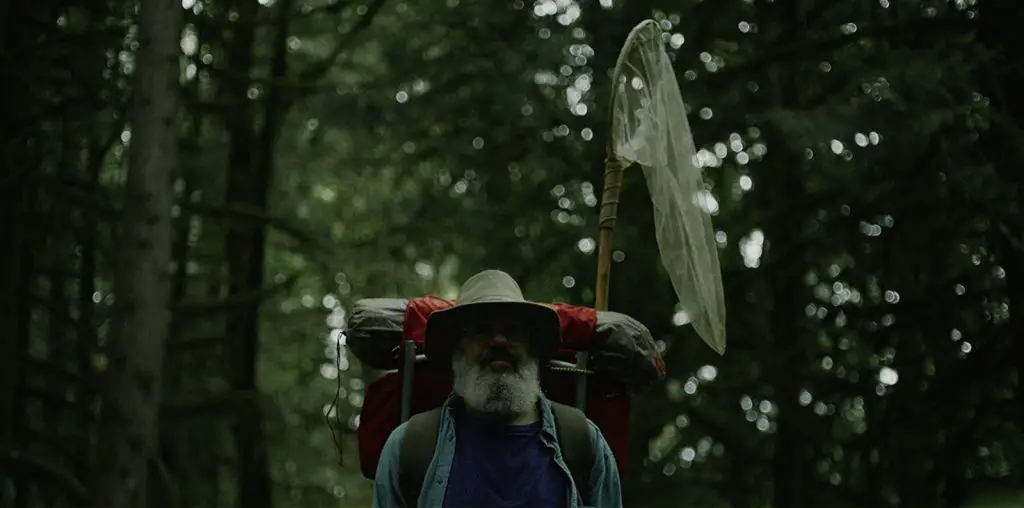
Betsy (Karis Yanike) is the landlord of an apartment complex. She runs a pawn shop. She smokes a lot. Her love life ebbs and flows. Sometimes, she gets robbed at work. Other times, life is unbearably routine. At all times, she does what she wants as she wants; as the title says, she lives her life.
From the very opening of She Lives Her Life, we are greeted with a text card informing us that the film is inspired by Jean-Luc Godard’s Vivre Sa Vie, and is dedicated to the filmmaker, the star of the film, Anna Karina, and the cinematographer, Raoul Coutard. The film’s website describes it as more than just being a piece inspired by Godard’s work, but a “modern retelling” of Vivre Sa Vie. Which, in execution, means a playfulness with, and updating of, the original film’s narrative elements while also utilizing much of the original’s more expressive and memorable camerawork and compositional moments.
This approach of sticking more with the visual language than slavishly to the original narrative allows filmmaker Mark Thimijan to explore the original film’s ideas in a new way. For example, Yanike’s Betsy here is not moving into the world of prostitution that Karina’s Nana experiences. Instead, there is a separate character, Hannah (Rachelle Brouillard), who brings that element of the story in. Betsy may share visual moments and the like with Nana, but her origin comes from the result of a different combination of sources.
Visually, the film is interested in keeping things close to the original, though it also branches off in other ways, including re-ordering imagery. Thus, not shot-for-shot (lest you’re thinking of what Gus Van Sant did with the concept with his remake of Hitchcock’s Psycho), here is instead an almost compositional greatest hits. Regardless of whether you’ve seen the original or not, much of it still comes across as fresh and vibrant to the eyes, and often experimental, though not too far into the realm as to be potentially confusing. Betsy dancing her way around a bar works here, as it did for Nana.
Instead, it’s a wonderful usage of visual language. Emotions are often given away by facial expressions or dialogue, sure, but in camera moves and editing? It can be done, but this additional palette isn’t something that is utilized as often as perhaps it could be. Again, whether you’ve seen the original film or not is moot, this reminds us that the narrative of a film can be formed by more than just what is said onscreen.
All that said, while we’re all inspired as artists by those that come before us, whether we know it or not, I wouldn’t have minded getting this type of film without such obvious throwbacks to the source material. When shots are shared between films, and credit is due to how they can be interpreted differently in each incarnation, there is still the question of whether you’re enjoying something for what it is now, or for where it came from. I have the same problem with music mashups.
Take Girl Talk, as an example; I’ll hear a track from him and find myself really enjoying it, but am I enjoying the way that Girl Talk assembled all these well-known and popular music elements to create something new, or am I just enjoying the well-known and popular music within period? Seldom do I walk away from listening to Girl Talk wanting to hear the song again so much as wanting to hear all the memorable music that went into it.
There’s a bit of that here too, as when She Lives Her Life wrapped up I wasn’t so intrigued as to watch it again as to revisit Vivre Sa Vie. Partially to see how the two stack up against one another, and partially because I was reminded of a film I appreciated that I hadn’t seen in a long time. The question then becomes, if you enjoy the experience, does it matter who gets the ultimate credit for that enjoyment? She Lives Her Life doesn’t exist without Vivre Sa Vie (or many other movies, no doubt), but it also isn’t Vivre Sa Vie, melting elements together enough to create its own vibe and personality.
Ultimately, it reminded me of my studio art education in college where, instead of sketching our own art or the like, early courses involved assignments where we were asked to recreate popular drawings, sketches or paintings, in an effort to put ourselves in the mindset of how they were created while also teaching us different techniques. Likewise, Hunter S. Thompson was said to have retyped The Great Gatsby and A Farewell to Arms in an effort to get the rhythm and feel for great writing. I don’t see this film as any different, and it has left me more excited about what work will come from filmmaker Thimijan in the future, having gone through the making of this one.
This film was submitted for review through our Submission for Review system. If you have a film you’d like us to see, and we aren’t already looking into it on our own, you too can utilize this service.
